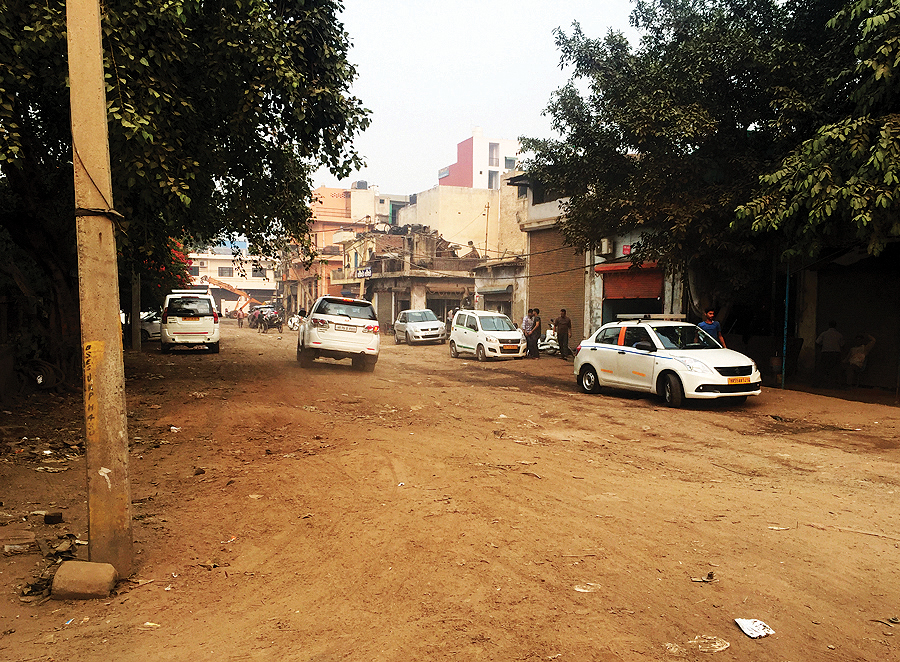Clouds of dust, ongoing construction work in some sites, open dumping of garbage — this isn’t what the supreme court had in mind
On November 4, a Supreme Court bench cited 16 “hotspot regions” in the NCR as the source for “major polluting activities” that need to be curtailed. Visits to some of these sites, however, revealed blatant non-compliance with the Supreme Court’s order.
The bench had said that “no demolition and construction activities” should take place in Delhi and NCR region. “In case it is found that such activity is done, the local administration as well as the municipal authorities including the Zonal Commissioners, Deputy Zonal Commissioners shall be personally held responsible for all such activities.”
The Supreme Court order quoted information on the air quality winter inspections in NCR till October 31 this year, sourced from an affidavit filed by the Ministry of Environment and Forests. It stated that the major sources of pollution in and around Delhi were construction and demolition, open dumping of waste/garbage, unpaved roads/pits, road dust, garbage burning and traffic congestion.
The top court directed the Delhi government “to chalk out immediate plan and to ensure that waste and garbage to be removed to safe places forthwith and also to ensure that no open dumping takes place.” To combat road dust, the court asked the government to use water sprinklers. And as for traffic congestion, it asked the traffic authorities to prepare a traffic plan “in such a manner so that there is no extra burden on a particular road…”
The court order then said “major polluting activities” could be traced back to 16 “hotspot regions” across the NCR. These include Okhla and Faridabad in the south, Sahibabad in the east, Dwarka in the west, as well as Punjabi Bagh and Narela in the north. For each of these regions, the court provided the polluting factors.
Newslaundry visited nine of these 16 regions across the NCR to look into the compliance with the SC order.
Punjabi Bagh
Construction & demolition
Punjabi Bagh lies in the West Delhi district of the Union Territory of Delhi. A significant part of this locality consists of colonies with residential homes.
Newslaundry visited 11 construction sites in Punjabi Bagh West and Punjabi Bagh East. We did not come across any site where construction or demolition work was ongoing.
Mukesh, a supervisor at a construction site in Punjabi Bagh East, says he had been ordered by the builder to pause work after the Supreme Court order. “There are lakhs in fine and we were told it is better to stop work than incur one,” he says. Om Prakash, who irons clothes for a living in Lane 27 of this area, says all three construction sites in the vicinity have stopped work.
Shanti Pal, who works at a construction site in Punjabi Bagh West, says the work in the area stopped after Diwali. “I have heard from people we are not allowed to work due to pollution,” she says.
Inside the locality’s Road 42, local guard Mukesh Kumar says the labourers working at the local construction sites there have gone home. “All the work in the colony has stopped.”
Mayapuri:
Unpaved roads, road dust
Starting from the Mayapuri metro station to Mayapuri Phase II, there are multiple diverging roads that are unpaved. Located in the South West Delhi district, these roads are dusty. Gravel lines the streets on both sides. This dust never settles as cars, motorcycles and trucks pass by at all times. The state of the roads is worse in the Phase II market in Mayapuri that is home to a local market for motor and machinery parts.
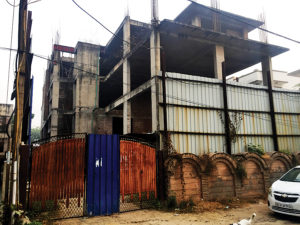
Mayapuri was at the centre of a sealing drive earlier this year. The drive was a result of a 2015 order by the National Green Tribunal that directed the shutdown of all “illegally and unauthorisedly operating scrap industries in Mayapuri generating chemicals, oils and poisonous fumes resulting in air pollution, deaths and diseases at large scale”.
After reports of non-implementation, the NGT in 2018 directed the constitution of a seven-member Special Task Force monitored by the Chief Secretary to enforce the order. In a report to NGT in January this year, the Delhi Pollution Control Committee claimed it had not collected any fines from the polluters.
But according to shopkeepers, NGT’s actions do not stretch to dusty roads. “The NGT harasses us every now and then,” says Sohail, who manages a shop in the market’s D block. “They take away our cars and products, but nothing is done about the dusty roads. This dust has almost become our energy drink — our workday can’t start without consuming it.”
In B block, Gurpreet Singh, who owns a car repair shop, says the state of the roads have taken a toll over the people’s health. “The roads of Mayapuri has remained unpaved from past 35 years,” he says. “It creates a lot of dust but nothing has changed in this area. Due to this, we suffer from regular cough and asthma.”
Narela:
Dumping and burning of industrial waste, dumping and burning of garbage
The industrial town of Narela, settled at the Delhi-Haryana border, is located about 40 kilometres away from the heart of Delhi in the North Delhi district. It is home to about 8 lakh people.
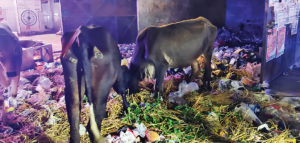
In the densely populated Saboli locality of Narela, residents tell Newslaundry that open dumping of garbage is a serious problem. Ashish Pandey, who works at a nearby pharmacy, says, “One has to see the condition of Saboli early in the morning. The garbage overflows to the road and causes a traffic jam. One can spot garbage on every corner of the road. A truck comes in the morning to collect the place looks a little better by afternoon. It’s a cycle.”
The situation is replicated at Narela’s Anaaj Mandi a couple of kilometres away. Saroj Devi, who has a shoe shop here, says the situation has not improved over the years. “Everyone in this area dumps garbage out in the open. There are also very few dustbins here out. I’ve been here from the past 13 years and the place has remained the same.”
“There is a traffic jam here everyday between 8.30 and 9.30 am,” Sajad Khan, an e-rickshaw driver who passes by Anaaj Mandi everyday. “That is usually when all the factory workers head to their jobs and it creates a huge traffic jam. It takes two full trucks to clean it up.”
On the outskirts of the town, residents say garbage is not only openly dumped but also burnt. At the Safiad road some two kilometres outside Narela, garbage accumulates and putrefies by the road. Most of it is ashen and indicates that it has been burnt recently.
“There was a fire at the site a week ago,” says Deepak, 28, a local. “The fire engines had come to extinguish it. The municipal corporation has been visiting the site since. We heard that people were also chalaaned for dumping here before.”
At one of the industrial sites in Narela, industrial waste has been dumped in plastic sacks. The site is open and adjoins the main road. Locals told Newslaundry that the dump last witnessed a fire in summer this year. There is also a fire hydrant installed outside, indicating the dangers of industrial waste catching fire.
“The industries dump garbage here every day. It is also cleaned every day. The local authorities come here at 7 am to clean this area,” says Manjeet Kumar, a resident at the industrial area.
Okhla
Open dumping of garbage, open dumping of industrial waste, construction & demolition
In South Delhi’s Okhla, open sites for garbage dumping are found in the middle of residential areas, by the road and behind buildings. The area is also home to one of Delhi’s largest landfills, where trash has been collected since 1996.
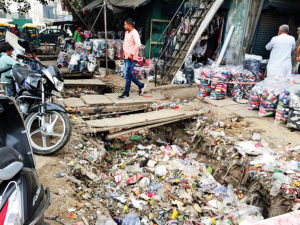
Dwarki, 35, who segregates and manages waste in Okhla Phase II, says not much has changed in Phase II since the top court’s order. “Open dumping has been clamped down on, especially in Phase III, but people have been dumping in the open in Phase I and II. These are especially people from the local slums: there are very few trash cans in these areas,” he says.
In Okhla, scrap dealers from private companies are tasked with collecting and segregating garbage in the area and then handing them over to vehicles that transport it to other sites. Dwarki says scrap dealers do not have much incentive to do this, alleging corruption in these firms.
Babloo Viswas, 34, is one of the scrap dealers in Okhla. His work involves collecting trash in the streets of Sanjay Colony, a working class locality.
“I am supposed to receive Rs 9,000 every month,” he says. “But all I get in Rs 3,000. My thekedar (supervisor) swindles the rest of the money. We have to go on strike every now and then to get that money.” He adds: “This place becomes a living hell when we’re on strike. There is garbage everywhere.”
Viswas works for the Dakshin Dilli Swachh Initiatives Limited, an organisation that describes itself as a “concessionaire” of the South Delhi Municipal Corporation.
Faridabad
Construction & demolition, open dumping of garbage, unpaved roads, open burning, industrial waste dumping
In Haryana’s Faridabad, beside the Bata Chowk metro station, construction work is in full swing. A concrete mixer machine roars as a tower crane shifts material around the area. Dozens of workers are active at the site: some have climbed up on the skeletal foundation of the building’s top floor while others move iron bars from one place to another. Mounds of earth lie in and around the site, uncovered and blowing in the evening breeze — covering roads, cars and people. A project manager says a mall is coming up.
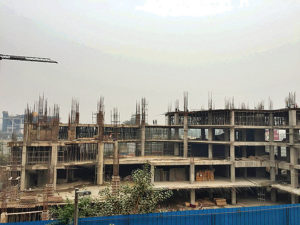
When asked about the situation at the site, Jai Bhagwan, the Regional Officer of the Haryana State Pollution Control Board, told Newslaundry that the pollution board remains vigilant. “We have teams doing the rounds to stop construction. We take action whenever a violation is brought to our notice,” he says.
At another large construction site in the vicinity, only menial work is on. A few workers are putting up light bulbs or cleaning the site, but there’s no active construction work. Ajay, a manager at the site, says the work had stopped way before the Supreme Court order: the company ran out of funds. The guard outside corroborates this.
Ajay says the local authorities appear every other day and water the overwhelmingly dusty roads outside his site. “Sometimes they don’t come, but ask us to do it,” he adds.
Open garbage lies uncollected and uncleaned in Faridabad. At one such site in Sector 9 in Faridabad, called Kali Mandir kudadaan (trash dump), we met Geetu, an 18-year-old scrap dealer. Geetu says the garbage of several sectors of Faridabad is dumped at the site.
“The garbage has been dumped here everyday for ages,” Geetu says. “People pay anywhere between Rs 600 to Rs 1500 for leaving trash here. It sells for Rs 2 per kilo and is taken away to Gurgaon.” Is it burnt too? “It isn’t, but people will start doing that once winter arrives. Men collect the garbage and set fire to it for warmth.”
Dwarka
Construction & demolition, unpaved roads
Subhash Pandey, a security guard who works in Sector 10, says the NDMC is sprinkling water on the road for the past week only due to “strict regulation”. “Otherwise when the dust increases, it’s rare for someone to clean it and put water. It just remains that way.”
There is no sign of ongoing construction activity in Sector 10. Several construction sites have been closed for the past 10-15 days, since Diwali.
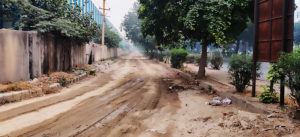
Suman, who works in a construction site, says labourers were told the work will resume in a few days. When asked if they’re still receiving daily wages, she says, “We’ve been promised Rs 9,000 for these days.”
In Dwarka’s Sector 11 is a piece of open, barren land called Function Site No. 17. The land is unpaved and garbage is dumped in the open. A handful of men were playing gilli danda when Newslaundry visited. One of them, Naveen Gupta, explains the site is often used to play cricket and other sports, or to practice driving. “Other than that, this place has no use. I’ve seen it like this for 5-7 years and nothing has changed.”
He adds that no water is sprinkled here to settle the dust.
Rajapur in Vishwas Park, Dwarka Sector 3, shows few signs of development. Roads are either unpaved or dug up, and there’s dust everywhere. The entire road running down Vishwas Park was dug up to lay pipelines. Residents said the streets have been this way for the past four months.
Subhas Kumar, who owns a small hotel in the area, says construction work ended after Diwali. “Someone from the municipal corporation comes in the morning to clean the streets,” he adds.
Jyoti Singla, who has lived here for 20 years and runs a grocery shop, says the streets here were never well-made but were walkable. “For the past two years, the government has done nothing to improve the conditions of the roads. To make it worse, the road was broken four months ago. This creates a lot of dust — I have to clear dust from every corner of my house every day. It’s become very difficult to live in this condition…Cold and cough is very normal here.”
A house under construction is in the same area. Electrical work was going on at the time of Newslaundry’s visit; the electrician, Sunil Kumar, says construction work isn’t happening just yet. Nearby, two plumbers are doing sewage work outside a house. One of them explains the sewage system of the house is blocked, so they’ve started work today.
Sapna Tanwar, publicity assistant at the South Delhi Municipal Corporation, says “regular precautionary activities” are carried out to regulate pollution. “Water sprinkling, deploying mechanical road sweepers to sweep the road, and imposing challans to those who carry out illegal construction and demolition activities — these are some of them,” she says.
When asked about the unpaved road in Vishwas Park, Tanwar said she isn’t familiar with the area but will send an engineer to have a look.
Sahibabad
Unpaved road, road dust, open waste dumping, construction & demolition
Rajesh Verma works as a security guard at Ingersoll Rand Technology and Service Private Limited in Sahibabad. He says people in the area always dump garbage in the open. “Last week, a man threw a half-lit beedi into this open dump and the whole place caught fire,” he says. “We had to call the fire brigade.”
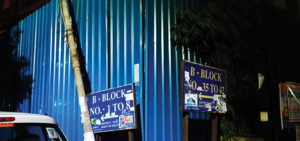
The roads of Sahibabad industrial area are unpaved. Akash Rawat, a cab driver, says, “The place has been like this for the past 10 years. I worked in a factory here seven years ago and it’s remained the same.”
Ramakant Lal, who works in a factory in Sahibabad, agrees. “Now I’m used to these unpaved roads. We’re poor people. If we can manage our meals, that’s a big deal for us. The pollution affects us the most — not those who travel in cars. Look at this place. The roads aren’t constructed, you find garbage everywhere. There’s a lot of dust in this area.”
Promod Kumar, Additional Municipal Commissioner of the Ghaziabad Municipal Corporation, says the corporation is “cleaning well” using mechanised road sweeping and water-sprinkling.
This correspondent told him what she had seen in Sahibabad industrial area. Kumar said, “We are in action to clean the area. We’re taking necessary action against construction and demolition. We’ve imposed fines on construction, dumping garbage and burning garbage in the area.” But what is the point if the industrial area’s streets still have garbage and remain unpaved? In response, Kumar said he has a meeting to attend.
Anand Vihar
Construction & demolition
Anand Vihar is one of the busiest parts of the national capital as it joins the city to the state of Uttar Pradesh. It has a busy bus terminal, the Anand Vihar Interstate Bus Terminal, and its own railway station as well.
Starting from Anand Vihar metro station to Anand Vihar colony, this correspondent found no indications of ongoing construction work. Several construction sites at Anand Vihar colony are temporarily closed.
Sampat Yadav, who has run a tea stall here for 20 years, says the construction work stopped after Diwali. “I know this because the construction works used to come to me for tea, samosa and pakora, but for the last 15 days, most of them have disappeared.”
Rishi Khan, a resident of Anand Vihar colony, also says he’s seen no construction work in the last 15 days.
Ghanshyam Yadav, a security guard at one of the closed construction sites, says there used to be a lot of dust in the area. “After the order prohibiting construction, the dust has reduced to a large extent in the area,” he says.
Vivek Vihar
Traffic congestion, construction & demolition, open dumping of garbage, road dust
When this correspondent visited the A and B Blocks of Vivek Vihar Phase 1, there was no sign of open dumping of garbage or traffic congestion. No work was ongoing at construction sites. RK Singhal, a resident of Vivek Vihar B Block colony, says construction work stopped after Diwali. The house next to his is being renovated, but he’s seen no work since the festival.
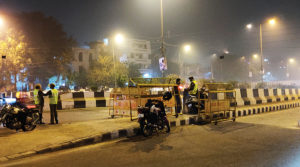
But behind D Block in Vivek Vihar Phase 1, opposite Yojna Vihar, trash overflows from a closed garbage dump. Manu Kumar, a rickshaw puller, says, “This is nothing. If you came 15 days ago, you’d have seen the trash spilling onto the road, creating a traffic jam in the early morning. Now that strict rules have been imposed, it gets cleaned in the morning.”
With respect to the traffic, Delhi Police personnel deployed in Kasturba Nagar underpass say the odd-even scheme has reduced traffic to a large extent. In Vivek Vihar Phase II, Delhi Traffic Police personnel told Newslaundry, “There used to be a lot of traffic in this area from 8 am to 11 am, and 5 pm to 8 pm, because of the bus stand and railway station…But after the government pushed challans, people are more cautious. Before, they could pay a fine of Rs 100 for not wearing a helmet and get away with it. Now, they know they have to pay a bomb — so people think twice.”
www.newslaundry.com

